How to Play the Chromatic Scale on the Saxophone


How to Play the Chromatic Scale
The chromatic scale contains all 12 pitches used in Western Music organized by half-steps. To learn the chromatic scale is to learn all the notes of your instrument. This is something I teach to all of my students in their saxophone lessons.
In this guide for the saxophone, you will learn how to play a continuous ascending chromatic scale with the proper fingerings- for the full range of your instrument! That's just over two and a half octaves from B♭3 to F6.
1. Bari players only: Play a low A

Modern baritone saxophones have an extra note that alto, tenor, and soprano don't have. You'll know if your horn has it if there's a key underneath your left thumb rest.
To play low A: depress your left index (B), middle (A), and ring finger (G) keys. Take your left pinky and reach for the low B♭ key. (pictured in red). In the right hand, depress your index (F), middle (E), and ring (D) keys. With your pinky, reach for the bottom of the two right hand pinky keys. (Low C).
Note that the low B♭ key is not required to play the note itself, but makes moving to A♯/B♭ much easier.
2. All saxophonists: play a low B♭/A♯

Baritone players, you're already playing the fingering for this note! Simply return your left thumb to the thumb rest to release the low A key.
Alto, tenor, and soprano players, depress your left index (B), middle (A), and ring finger (G) keys. Take your left pinky and reach for the low Bb key. (pictured in red). In the right hand, depress your index (F), middle (E), and ring (D) keys. With your pinky, reach for the bottom of the two right hand pinky keys. (Low C).
All of your fingers are in use for these first two notes. Don't grip! Use only the pressure necessary to fully open or close each key.
3. Roll your left pinky finger up to play low B

The low B key is is one of two keys directly above the B♭ paddle. Low B is the key on the inside, or the key to the right.
Maintain the pressure on the pinky keys while gliding your left pinky toward your left ring finger. Use the pinky key rollers, (the spinning beads) to carry your pinky over to the next key, minimizing friction.
4. Lift your left pinky to play low C

Keep the lifted pinky near the 4 pinky keys. Keep the finger rounded. Don't extend, or flex completely toward the palm.
5. Lightly flex the left pinky in toward the palm, and depress the outside paddle key to play C♯/D♭

Be careful not to grip your fingers. use only the pressure required to close and open the tone holes.
6. Lift both pinkies to play D

While the pinkies take a brief break, touch them (without pressing the key) to the left and right upper paddle keys.
7. Depress the upper right pinky key play D♯/E♭

Get in the habit of touching the pinky to the paddles at all times, so they don't fly off the keys when you need them.
8. Lift your right pinky and ring finger to play E

Again, don't extend the fingers. Just enough to change the pitch to E.
9. Lift your right middle finger to play F

Allow the finger to follow through as it releases, but don't point it.
10. Flex your right ring finger slightly toward the palm, and depress the key to play F♯/G♭
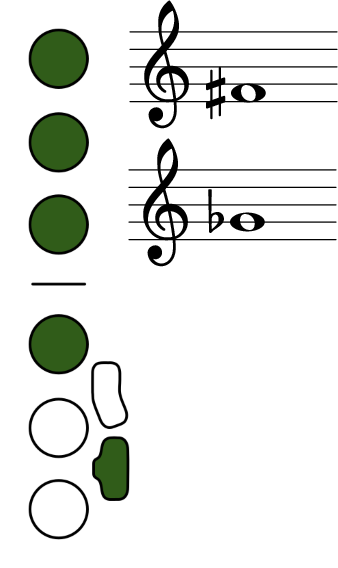
Flex the right ring finger in toward the palm to find the side F♯ key. Depress this in combination with your previous F fingering.
It's important to use this F♯ over the middle finger F♯, because this fingering allows you to avoid contrary motion between your index and middle finger, which can slow you down and cause mistakes during chromatic passages.
11. Lift your right index and ring finger to play G

The right hand takes a break. Remember to keep the fingers in contact with the key pearls. Don't drop the fingers to the side, let go of the horn, or point the fingers.
12. Depress the top left hand pinky key to play G♯/A♭

Use just enough pressure to depress the key.
13. Lift your left pinky and left ring finger to play A

Pay attention to the key action. Don't lift too far from the key pearls. Keep the fingers rounded.
14. Depress the lowest side key with your right index finger to play A♯/B♭

Keeping the thumb in place under the thumb hook, slightly pronate your right forearm, and depress the bottom side key with the largest segment of your index finger (technically called your proximal phalanx). Your fingers will have to come away from the main key pearls. Keep your fingers together and rounded to ease the eventual return to the key pearls.
15. Release the your right index finger and left middle finger to play B

Release the right side key with a very slight supination of the forearm. Keep your fingers near the side keys. Don't return to the key pearls just yet.
16. Depress the middle side key with your right Index finger to play C

Like B♭, pronate your forearm slightly. But this time you will reach for the middle side key with your proximal phalanx.
17. Release the right and left index fingers to play C♯/D♭
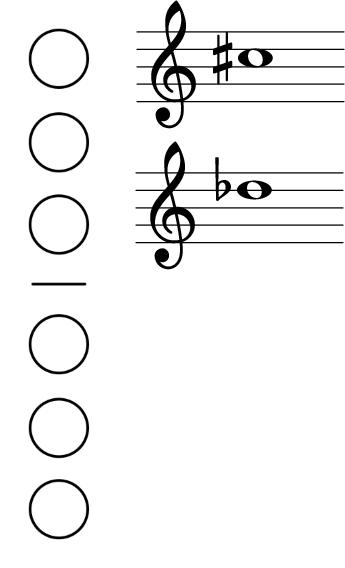
This is the open note on the saxophone. No fingers are needed to play it, however, you should prepare for the next tone by continuing to touch the key pearls.
18. With both hands, depress your index, middle, and ring finger keys, and depress the octave key with the tip of your left thumb.

Depress the octave key like a gas pedal. The palm-side knuckle of the small segment of the thumb (the distal phalanx) is like your heel, and fleshy pad of the thumb is like your big toe. Keep your heel on the floor (thumb rest) and lightly put your toe on the gas pedal. Get ready to cruise. Don't floor it! You could hurt somebody!
19. Keep the octave key depressed, and repeat fingerings from D♯/E♭ through C-sharp/D-flat





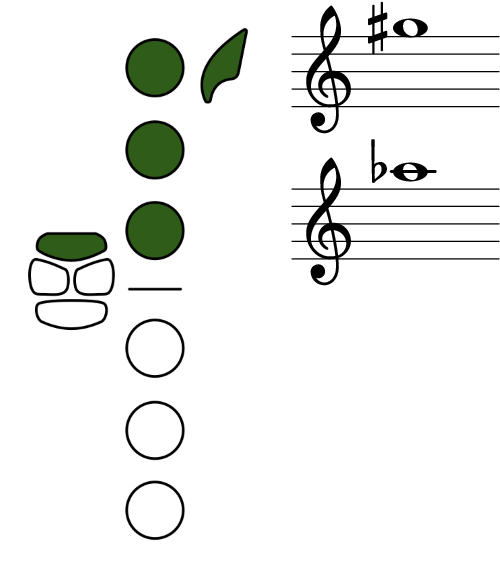



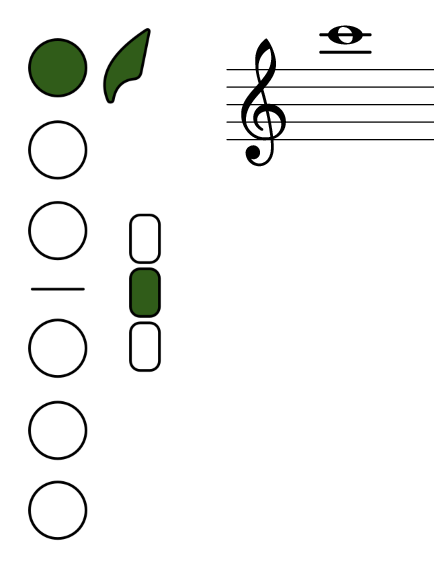
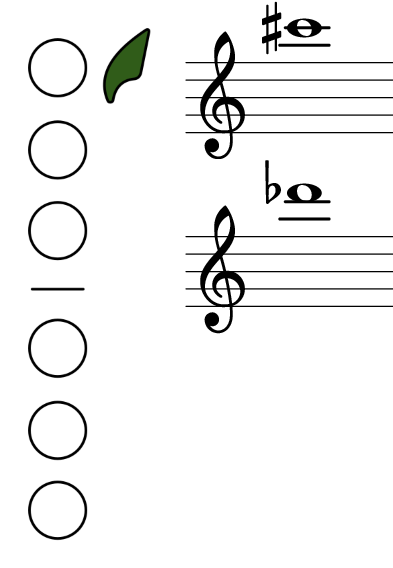
Behold the power of the octave key! You don't need to learn any new fingerings for the saxophone's second register. The technique is just the same as the first register. The only difference is that the thumb stays put on the octave key for the remainder of the saxophone's range.
20. Depress the palm D key with the first knuckle of the left hand.

Your left fingers may need to leave the key pearls to allow the knuckle to properly press this key. Continue to keep the fingers rounded.
21. Depress the palm E♭ key with your second knuckle of the left index finger
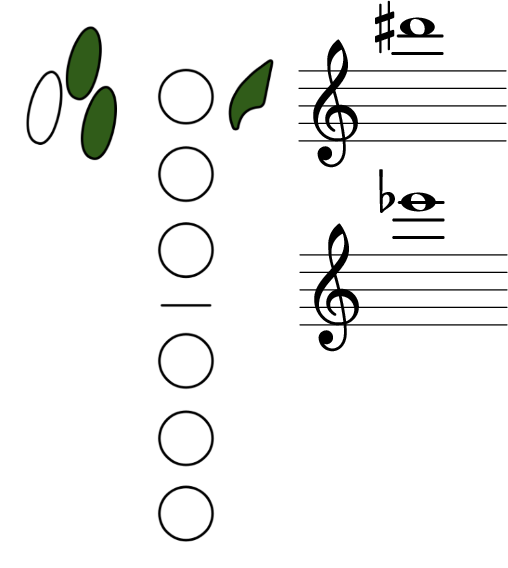
You will contact this key either with the second knuckle, or the fleshy part of the proximal phalanx of your index finger depending on the size of your hands.
22. Depress the top side key with your right index finger

Like side B♭ and side C, pronate your right forearm slightly farther this time to reach the top side key. Use the proximal phalanx to press the key in. No fingertips!
23. Depress the palm F key with the second knuckle of the left middle finger

Like high E♭, You will contact this key either with the second knuckle, or the fleshy part of the proximal phalanx, but this time with the middle finger.
Fingering Chart
You've done it! Congratulations. You've played each note in the standard range of the saxophone. And with proper technique! If you want to play the descending chromatic scale, you just need to do the same steps in reverse. Now that you know the proper technique for each note, use this fingering chart as a quick reference for the chromatic scale.

Related



